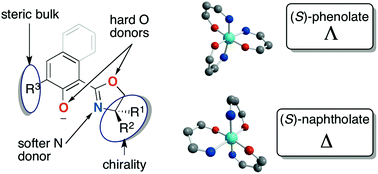Adding the right (or left) twist to tris-chelate complexes – coordination chemistry of chiral oxazolylphenolates with M3+ ions (M = Al or lanthanide)†
Abstract
A series of homoleptic tris-chelate complexes ML3 (M = Al or rare earth; L = chiral or achiral oxazolyl phenolate or -naphtholate) is reported. In all cases, complexes crystallize as mer-isomers and complete diastereoselectivity is observed on crystallization of the complexes: ML3 crystallize with Λ-helicity at the metal where L = (S)-oxazolylphenolate. Complexes have been characterized in solution by NMR spectroscopy, demonstrating rapid ligand exchange at ambient temperature for rare earth complexes, and slow exchange on the NMR timescale for complexes of Al; in all cases the mer-isomer is observed exclusively. Crystal structures are reported for [YL3]2 (L = (S)-2-(4-isopropyl-4,5-dihydrooxazol-2-yl)-phenolate), mer-[YbL3] (L = (S)-2-(4-isopropyl-4,5-dihydrooxazol-2-yl)-6-methylphenolate) and mer-[AlL3] (L = (S)-2-(4-isopropyl-4,5-dihydrooxazol-2-yl)-6-methylphenolate, L = (S)-2-(4-isopropyl-4,5-dihydrooxazol-2-yl)-6-cyanophenolate), L = (S)-1-(4-isopropyl-4,5-dihydrooxazol-2-yl)naphthalen-2-olate, L = 1-(4,4-dimethyl-4,5-dihydrooxazol-2-yl)naphthalen-2-olate).


 Please wait while we load your content...
Please wait while we load your content...